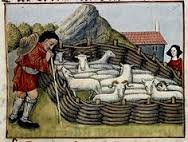November was a busy month in the medieval world. Last week’s post focused mainly on the fall slaughter and preservation of meat for the coming months, but there was much more to be done. Garlic and beans were sown in November–typically around the 20th, which was St. Edmund’s day–but the heavy labors of the field were largely complete. It was time to take on other onerous, but necessary tasks such as digging ditches and trenches, and cleaning out the farm yard and latrines. Animal and human waste was spread as a fertilizer for gardens and fields. Walls would be checked and repaired in November, and molehills removed.
 Beehives were given attention to make sure that the bees were getting enough nourishment to survive the coming winter. Young hives were in particular danger of starving since they’d had less time to store up food for themselves. According to Thomas Tusser (English farmer and poet), the weight of the hives should be checked and the bees fed if needed. “Go look to thy bees; if the hive be too light, set water and honey with rosemary dight. Which set in a dish full of sticks in the hive, from danger of famine, yea save them alive.”
Beehives were given attention to make sure that the bees were getting enough nourishment to survive the coming winter. Young hives were in particular danger of starving since they’d had less time to store up food for themselves. According to Thomas Tusser (English farmer and poet), the weight of the hives should be checked and the bees fed if needed. “Go look to thy bees; if the hive be too light, set water and honey with rosemary dight. Which set in a dish full of sticks in the hive, from danger of famine, yea save them alive.”
 As long as the winter didn’t become too harsh, many of the sheep could be held back from the fall slaughter. Sheep were able to live on terrain that was unsuitable for other animals. They had no trouble grazing in areas that were rocky and too difficult to clear for agricultural use. Sheep could also be used to crop the farming fields short, fertilizing them with droppings as they went. As the weather grew colder, their thick wool helped to protect them, as well as sheep folds, made out of wooden hurdles. These were woven panels, typically made out of hazel wood, which could be moved around as needed. They kept the sheep enclosed and blocked much of the wind at the same time. If the weather turned too much for them to survive outdoors, or there was a shortage of food, the sheep could always be slaughtered later to provide an immediate source of fresh meat.
As long as the winter didn’t become too harsh, many of the sheep could be held back from the fall slaughter. Sheep were able to live on terrain that was unsuitable for other animals. They had no trouble grazing in areas that were rocky and too difficult to clear for agricultural use. Sheep could also be used to crop the farming fields short, fertilizing them with droppings as they went. As the weather grew colder, their thick wool helped to protect them, as well as sheep folds, made out of wooden hurdles. These were woven panels, typically made out of hazel wood, which could be moved around as needed. They kept the sheep enclosed and blocked much of the wind at the same time. If the weather turned too much for them to survive outdoors, or there was a shortage of food, the sheep could always be slaughtered later to provide an immediate source of fresh meat.
 Like the bees, sheep required special attention in autumn, however. There were certain illnesses they were likely to contract, such as sheep scab and liver-fluke. Liver-fluke was caused by the sheep eating snails or mildew off of fallen leaves. Both illnesses were cured by applying tar–an important substance for medieval peasants to have on hand for a variety of uses, such as keeping the drafts out of homes, and making ships water tight.
Like the bees, sheep required special attention in autumn, however. There were certain illnesses they were likely to contract, such as sheep scab and liver-fluke. Liver-fluke was caused by the sheep eating snails or mildew off of fallen leaves. Both illnesses were cured by applying tar–an important substance for medieval peasants to have on hand for a variety of uses, such as keeping the drafts out of homes, and making ships water tight.
2 thoughts on “Medieval Monday: More Labors of November”